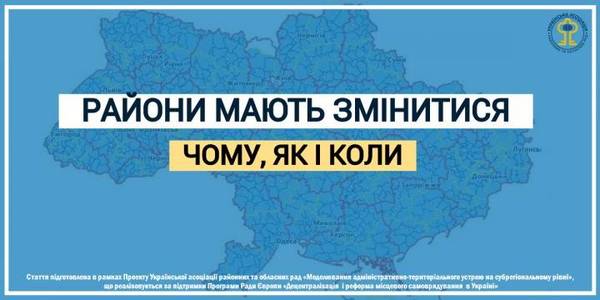Why, how and when should rayons change?
Both the number and functions of the rayon level of self-government in Ukraine need to change. First, it is envisaged by the Government's concept of the local self-government reform and administrative-territorial organisation of power. Secondly, it is already a demand of the real state of affairs in managing the territories.
Recently, in the Parliament, MinRegion presented its own vision of the reform of rayon (subregional) level of local self-government. According to the Ministry's estimates, 102 new more capable and efficient rayons should be created instead of 490 operating ones.
These are, of course, only preliminary calculations. The final decisions will be made by the Verkhovna Rada in laws developed following consultations of experts and government officials with representatives of hromadas, rayons and oblasts.
Why should rayons be reformed: 6 arguments
Argument I. Rayons have fewer and fewer grounds for common representation of hromadas’ interests. In the course of decentralisation, amalgamated hromadas formed on all or major territory of many rayons took over almost all the powers of the rayon state administrations and rayon councils, and came out of their subordination. Of course, there are questions about efficiency of such rayons.
Argument II. Resources at the rayon level are not used rationally.
Argument III. Rayons do not coordinate the territorial units of central executive bodies.
Argument IV. Rayons will no longer be in charge of the secondary healthcare link. The ongoing medical reform in Ukraine stipulates that hospitals, which are now rayon institutions, will be funded from the state budget through the National Health Service of Ukraine from 2020.
Argument V. There will be no more services people will need to receive “in the rayon”.
Argument VI. Rayon level is too finely divided.
Proposals to reform rayons
According to Pavlo Ostapenko, MinRegion’s expert group representative, the general algorithm for reforming the rayon level is as follows:
First - complete the modeling of the system of administrative-territorial units of the basic level (amalgamated hromadas) for each oblast.
Second – carry out analysis of the territorial organisation of power and hospital district network of the oblast.
Third – model the system of new rayons for each oblast according to the developed methodological recommendations.
There is an expert group working at MinRegion, which deals with modeling of the administrative-territorial division in the oblasts. They have already developed a methodology for the formation of new rayons, forwarded by the Ministry to the oblast state administrations for consideration in their work. This document is in the form of recommendation so far.
What does the methodology of capable rayon level formation envisage?
According to the methodology, the territory of new rayons should be compact, geographically integrated and connected (with no territorial enclaves and exclaves). The rayon population should be at least 150 thousand people.
The new rayon centres will primarily be the cities – oblast centres, as well as cities with a population of not less than 50 thousand people, if they are located not closer than 30 kilometres from the border of the city – oblast centre.
What powers will new rayons have?
The expert group at MinRegion is still of the opinion that there are a number of functions that hromadas cannot cope with on their own, especially since there should be the rayon level in the country, according to the Constitution.
The new powers for new rayons should precisely include:
-
Supervision of compliance of LSG decision with the Constitution and laws.
-
Coordination of activities of central executive authorities’ subdivisions within the rayon.
-
Local environmental policy.
-
Development and support of infrastructure projects of rayon significance, coordination of projects of the State Regional Development Fund.
This list is not exhaustive and may be modified after consultations with representatives of hromadas, rayons and oblasts.
When and by whom will new rayons be formed?
In order to complete the formation of an effective decentralised system of local self-government in the country, regular local elections in the autumn of 2020 should be held on a new territorial basis for hromadas and rayons. To this end, all necessary laws and governmental decisions must be adopted by summer 2020 at the latest.
Planning of the future territorial structure of certain oblasts is already underway.
Therefore, most oblasts already have a clear understanding of what their new division into rayons and hromadas will look like. Until the final decisions are made, hromadas have time to amalgamate voluntarily, and rayon representatives can express their position, propose solutions, including during expert and ongoing discussions in the regions.
The article was prepared within the framework of the Project of the Ukrainian Association of Rayon and Oblast Councils “Modeling of the Administrative and Territorial Structure at Subregional Level”, implemented with the support of the Council of Europe Programme “Decemntralisation and Local Government Reform in Ukraine”
The full version is available in Ukrainian – please click HERE

Tags:
administrative and territorial structure rayon Ukrainian Association of Rayon and Oblast Councils
Source:
УАРОР

13 December 2025
Межа у 300 операцій: як формальний критерій може знищити хірургію в малих громадах
Межа у 300 операцій: як формальний критерій...
Поки країна зосереджена на викликах війни — у сфері охорони здоров’я ухвалюються рішення, наслідки яких можуть стати...
13 December 2025
Уряд затвердив оновлені підходи до реалізації...
Кабінет Міністрів України ухвалив документ «Особливості реалізації Концепції реформування місцевого самоврядування та...
12 December 2025
French experience for Ukrainian communities:...
During their visit to France, members of the Ukrainian Parliamentary Committee on State Administration, Local...
12 December 2025
Коли знання запускають участь: як Здолбунівська...
Авторки: Тетяна Лукеря, Олександра Койдель – Центр демократичної стійкості (Київська школа економіки) Частина...